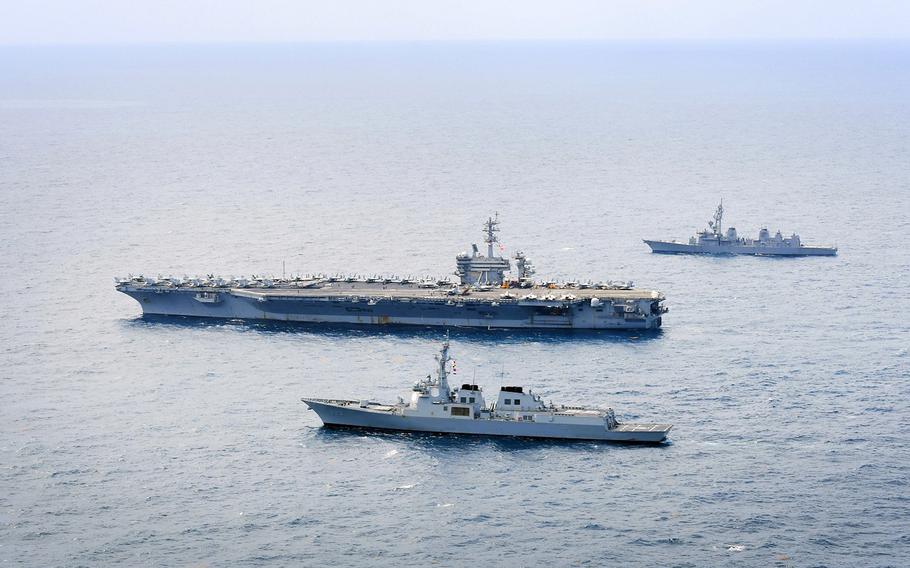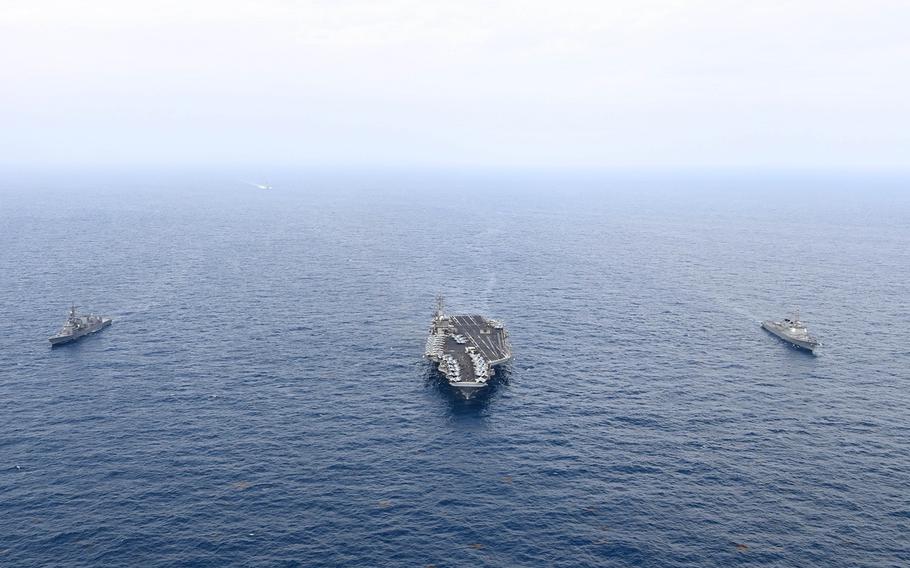
The aircraft carrier USS Theodore Roosevelt trains with the Japanese destroyer JS Ariake, top, and South Korean destroyer Seoae Ryu Seong-ryong south of Jeju Island, South Korea, April 11, 2024. (South Korean navy)
SEOUL, South Korea — The U.S., South Korean and Japanese navies trained together in the East China Sea on Thursday and Friday as President Joe Biden met with Japanese Prime Minister Fumio Kishida in Washington.
The aircraft carrier USS Theodore Roosevelt and guided-missile destroyers USS Howard, USS Daniel Inouye and USS Russell took part in the exercise, according to a South Korean navy news release.
The Associated Press reported the training took place in the East China Sea, a strategically important area surrounded by Japan, Taiwan, South Korea and China. The South Korean navy said the drills occurred south of Jeju Island.
The U.S. has conducted several exercises with its allies in the region recently to demonstrate a common defense in the event of aggression from China or North Korea.
The Japanese destroyer JS Ariake and the South Korean destroyer Seoae Ryu Seong-ryong joined the drills for anti-submarine tactics, search and rescue and maritime interception, the South Korean navy said.
The exercise “was a great opportunity for us to strengthen our capacity to respond to North Korea’s nuclear and [weapons of mass destruction] threats and provide humanitarian assistance to ships in distress …,” according to the release.
It also underlined improving relations between South Korea and Japan, old foes in the early 20th century.
Biden commended Kishida at a White House news conference Wednesday for “taking the brave step of mending ties with [South Korea] so we can all stand shoulder to shoulder together.”

The aircraft carrier USS Theodore Roosevelt trains with the Japanese destroyer JS Ariake, left, and South Korean destroyer Seoae Ryu Seong-ryong south of Jeju Island, South Korea, April 11, 2024. (South Korean navy)
Kishida and his wife, Yuko Kishida, made a weeklong trip to Washington, where the leaders addressed a long agenda, including possible reconfiguration of the U.S. command in Japan. Biden invited Kishida and Philippine President Ferdinand Marcos to the White House for their first talks Thursday, according to AP.
“We welcomed the progress seen in many areas of cooperation based on the outcome of the Japan-U.S.-[South Korea] summit last August and concurred to coordinate even more closely as we face serious concerns under the current state of affairs,” Kishida said during the news conference.
Rear Adm. Christopher Alexander, commander of Carrier Strike Group Nine, said Thursday on the Theodore Roosevelt that the exercise would improve communication among the United States and its allies and “better prepare us for a crisis in the region,” the AP reported Friday.
“It is a busy time; there is a lot going on in the world,” Alexander said, according to the report. “The significance of this exercise is we have three like-minded countries, three like-minded navies that believe in peace, security and stability in the western Pacific.”
The three navies last trained together in November, when the aircraft carrier USS Carl Vinson and guided-missile destroyers USS Sterett and USS Kidd drilled with South Korean and Japanese destroyers.
Trilateral military exercises kicked into high gear after leaders of the three countries held a summit at Camp David, Md., in August.
Biden, Kishida and South Korean President Yoon Suk Yeol agreed to “align our collective efforts” to address North Korea’s “unprecedented” ballistic missile nuclear threats, in a statement following their meeting.
“The United States unequivocally reaffirms that its extended deterrence commitments to both Japan and [South Korea] are ironclad and backed by the full range of U.S. capabilities,” the statement said. “Our three countries announce today that we intend to hold annual, named, multi-domain trilateral exercises on a regular basis to enhance our coordinated capabilities and cooperation.”